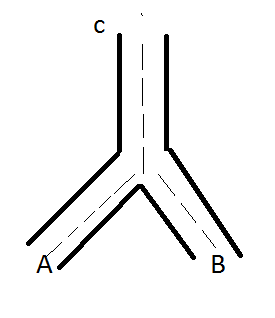The system shown in the figure is used for painting in factory. The speed of the paint that enters the system at the same speed and pressure from the A and B arms and exits the C arm, is 16,2 m /s when it hits the fabric. Accordingly, calculate the speed of the paint (ρ = 862 kg/m3) from the system (UC=?), the speed and pressures in sections A and B (PA=?, PB=?, UA=?, UB=?, PK=?, UK=?), and the reaction force (Fx=?, Fy=?, its direction) to keep the system in balance. Minor and major losses are neglected. Pipe diameters are DA = DB = DC=26,2 mm. Solve the problem by making the necessary assumptions and drawing the schematic figure. (a=6 and b=2 on the figure)
The system shown in the figure is used for painting in factory. The speed of the paint that enters the system at the same speed and pressure from the A and B arms and exits the C arm, is 16,2 m /s when it hits the fabric. Accordingly, calculate the speed of the paint (ρ = 862 kg/m3) from the system (UC=?), the speed and pressures in sections A and B (PA=?, PB=?, UA=?, UB=?, PK=?, UK=?), and the reaction force (Fx=?, Fy=?, its direction) to keep the system in balance. Minor and major losses are neglected.
Pipe diameters are DA = DB = DC=26,2 mm.
Solve the problem by making the necessary assumptions and drawing the schematic figure.
(a=6 and b=2 on the figure)

Given data:
a = 6 and b =2
Speed of the paint, u = 1(ab) = 1(12) = 12 m/s
Density, ρ = 8(ab) = 84 kg/m3
Pipe diameter, DA= DB= DC = 2(ab) = 2(12) = 24 mm.

Applying continuity equation for the given pipe:

Let us assume that the flow is incompressible thus,
ρA = ρB = ρC
and also given: AA = AB = AC
thus, the equation becomes:

Now, applying Bernoulli’s equation between points A and C.

Step by step
Solved in 5 steps with 6 images









